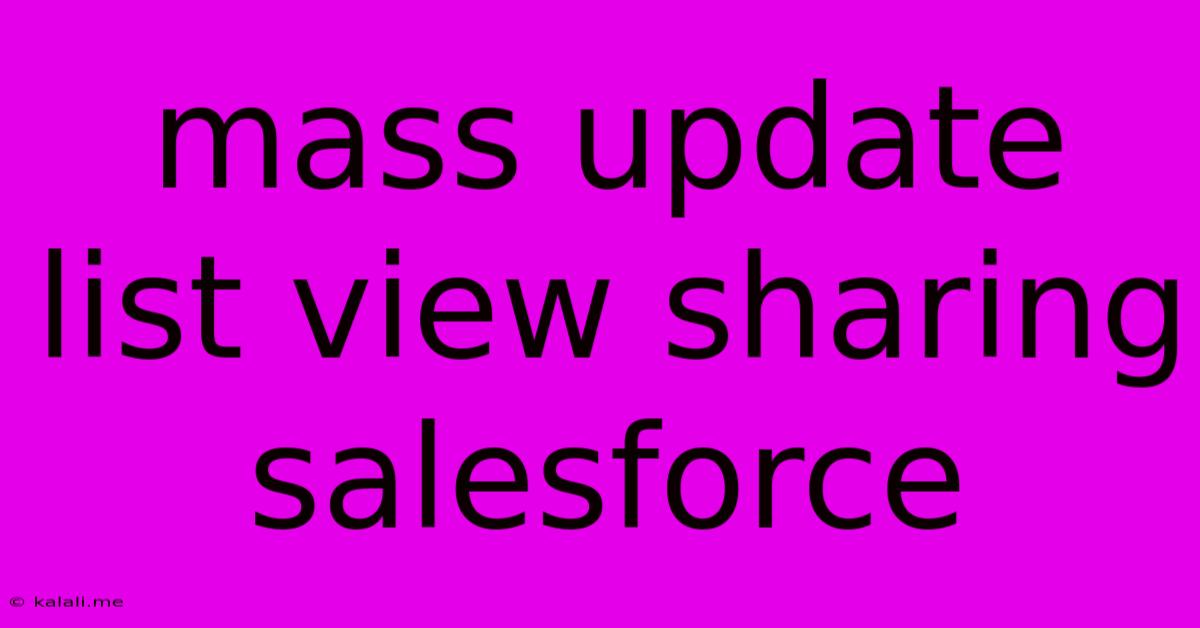Mass Update List View Sharing Salesforce
Kalali
Jun 03, 2025 · 4 min read

Table of Contents
Mass Update List View Sharing in Salesforce: A Comprehensive Guide
Salesforce list views are a powerful tool for organizing and filtering your data, but managing sharing settings for numerous list views can become a tedious task. Manually updating sharing rules for each list view individually is inefficient and prone to errors. This article delves into effective strategies for performing mass updates to your list view sharing settings, saving you valuable time and ensuring consistent data access control. Learn how to streamline your Salesforce administration and maintain efficient data governance.
Understanding List View Sharing in Salesforce
Before diving into mass updates, it's crucial to understand how list view sharing works. Unlike record-level sharing, list view sharing determines which users can see a specific list view, not the underlying data itself. If a user doesn't have access to the list view, they simply won't see it in their Salesforce navigation. This is different from object-level permissions or sharing rules which determine data access. This mechanism provides granular control over which users see specific data subsets.
The Limitations of Manual Updates
Manually updating sharing settings for each list view is cumbersome, especially when managing numerous views. This approach is:
- Time-consuming: Updating dozens or hundreds of list views individually requires significant time investment.
- Error-prone: Human error is inevitable when performing repetitive tasks, leading to inconsistencies in sharing settings.
- Inconsistent: Manual updates make it difficult to maintain consistent sharing rules across multiple list views.
Strategies for Mass Updating List View Sharing
While Salesforce doesn't offer a built-in "mass update" button for list view sharing, several strategies can significantly streamline the process:
-
Apex Triggers and Classes: For advanced users with Apex coding experience, custom Apex triggers and classes can automate list view sharing updates. This provides the most flexibility and control but requires significant development time and expertise in Salesforce's programming language. This approach is ideal for complex scenarios and large-scale deployments.
-
Data Loader or Import Wizard: These tools allow you to import and export metadata, including list view sharing settings. You can modify the sharing settings in a spreadsheet, then import the updated information back into Salesforce. This approach is suitable for bulk updates and requires some familiarity with CSV files and data manipulation. Careful planning and validation are crucial to avoid unintended consequences.
-
Third-party Apps: Several AppExchange apps specialize in managing and automating Salesforce metadata, including list view sharing. These apps often offer user-friendly interfaces for bulk updates, simplifying the process considerably. Evaluate the features and pricing of different apps to find one that aligns with your needs. Be sure to thoroughly vet any third-party application before implementing it in your Salesforce org.
-
Leveraging Sharing Rules (for indirect control): While you can't directly mass update list view sharing via sharing rules, strategically designed sharing rules on the underlying objects can indirectly influence who can see the data within those list views. This isn't a direct solution for list view sharing but can help manage who accesses the data displayed in those views.
Best Practices for Managing List View Sharing
Regardless of the method you choose, follow these best practices to maintain efficient data governance:
- Regularly Review Sharing Settings: Periodically review your list view sharing settings to ensure they remain aligned with your organization's access control policies.
- Document Your Sharing Rules: Maintain clear documentation outlining your list view sharing strategy and rationale.
- Use Descriptive List View Names: Clearly named list views make it easier to understand their purpose and sharing settings.
- Implement a Change Management Process: Establish a process for approving and implementing changes to list view sharing rules to minimize disruptions.
Conclusion
Mass updating list view sharing in Salesforce isn't a straightforward task, but by employing the strategies outlined above, you can significantly reduce the time and effort required, reducing the risk of errors and ensuring consistency across your organization. Choosing the right method depends on your technical expertise and the scale of your update. Remember to carefully plan and test your chosen approach before implementing it in a production environment. Prioritizing clear documentation and regular reviews will safeguard your data and enhance the efficiency of your Salesforce administration.
Latest Posts
Latest Posts
-
Permanenet Magnet Generator Vs Permanent Magnet Exciter
Jun 05, 2025
-
Wiring A Switch For A Garbage Disposal
Jun 05, 2025
-
Finding The Natural Response Of A Ivp
Jun 05, 2025
-
What Dice To Roll For Sleight Of Hand 5e
Jun 05, 2025
-
How To Feed Young Month Old Pigeons Food
Jun 05, 2025
Related Post
Thank you for visiting our website which covers about Mass Update List View Sharing Salesforce . We hope the information provided has been useful to you. Feel free to contact us if you have any questions or need further assistance. See you next time and don't miss to bookmark.